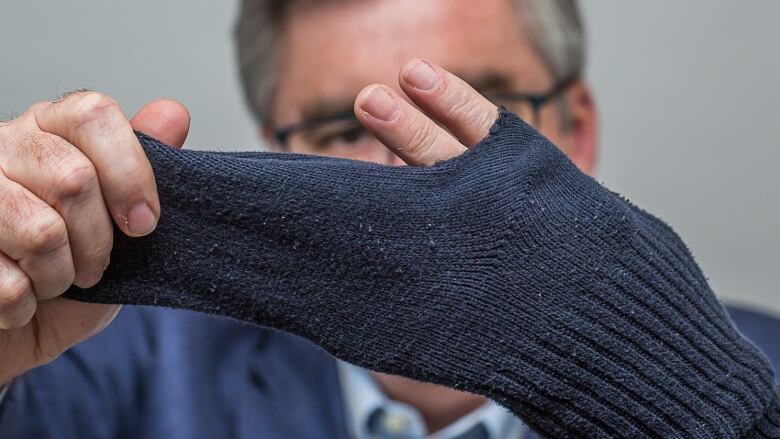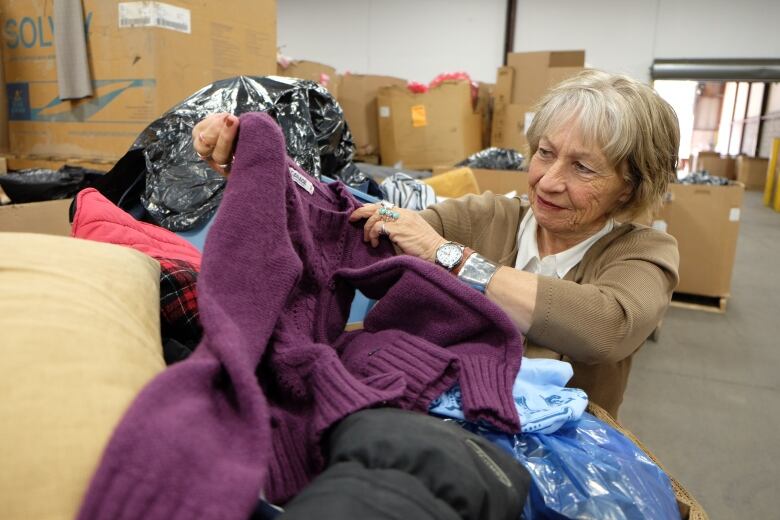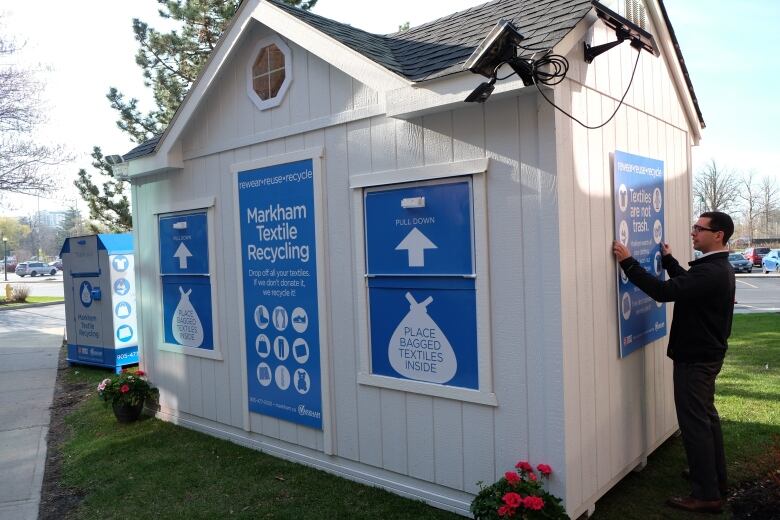Textiles are the next frontier in recycling for cities looking to cut waste
About 85% of the clothes we discard ends up in the landfill, but some municipalities are trying to change that

It started with a blue sock.
I pulled it off and realized it had a big hole in the heel.I balled it up and was about to test my athletic skill by attempting a long, basketball-style shot into a waste can when I paused.
Was that the right thing to do? Shouldn't my sock go somewhere else?
We recycle a lot in my community. I sort metal, glass, plastic, paper and cardboard for pickup.At my house, we compost tea bags and rinse out milk bags. I take batteries and electronics to drop-off points, along with cans of paint.And that isn't the end of it.
But my sock?Could that be recycled?
Research led me almost immediately to Claudia Marsales at the Cityof Markham, a senior waste manager so committed to recycling she has been dubbed "the Queen of the Heap."
'Off everybody's radar'
And the queen is making textiles her top priority.
"For 30 years,we have been recycling newspapers," she fumed. "Textiles has just been off everybody's radar."
A recent study in Ontario concluded 85 per cent of discarded textiles end up in a landfill site, meaning just 15 per cent are recycled or reused.
"We want to increase recycling of textiles to 100 per cent," Marsales said firmly.
That isn't as easy as it might sound.

Some municipalities pick up textilesColchester, N.S., launched its program just last week but there is a basic problem. Compared to glass or plastics, textiles don't lend themselves tocurbside pickup.
While bottles and cans can be thrown in a bin, ready for recycling day, that gentlyused sweater, which could be sold and worn again by someone else, can quickly become a smelly mess if mixed up with other waste. Or even if it simply rains.
Aided by a grant from the Federation of Canadian Municipalities, Markham, a city of roughly 350,000 north of Toronto,is rolling out a pilot program with a different approach.

Working with the Salvation Army, the city is pushing residents to recycle textiles while, at the same time, trying to make that easy.
Donation bins are being set up around the city, some as big as large garden sheds.They will have sensors to signal when the boxes are getting full. All are marked with the city logo, although the Salvation Army will be the one to process everything collected, just as it doeswith items donated through itsown boxes.
The difference is that Markham hopes to bring in absolutely every last piece of clothing any resident discards.
Lots of money in textiles
The city has spent a lot of time thinking about how to convince people to recycle more. Focus groups turned up some surprising problems.
"People only thought you could donate something that was perfect," Marsales said. "They really felt the poor shouldn't have to wear something that wasn't."

Research also showed that people were more likely to donate high-end clothing. Cheaper items went into the trash.
"All of it can be recycled. All of it should be donated," Marsales said. "There's lots of money in textiles."
A TommyHilfigershirt might feed a family of four.- Bill May, facilities manager, Salvation Army
To prove her point, we met in a huge Salvation Army warehouse in Oakville, Ont., where items are sorted.Top quality clothing sells quickly in the charity's network of stores and generates cash for the organization.
"A Tommy Hilfiger shirt might feed a family of four," said Bill May, the Salvation Army's properties and facilities manager.

But what comes back to the warehouse, unsold, isn't useless.
The clothing and other textiles are compacted, put into huge 450 kg bales and sold to private companies. Items are then sold outside of Canada or turned into other products, such as rags, certain types of paper, insulation or specialized fibre-basedmaterials used in agriculture,medicine or even diapers.
- Tim Hortons, Starbucks recycling claims may be garbage
- Excessive packaging frustrates consumers: Poll
"This is old gym shorts," May said, picking at an article in a bale. "Nobody wants to re-wear them, but we can certainly send them to a cloth recycler who can make them into a useful product."

Even my old sock would be welcome.
"Horrible shape is horrible shape, but we can still find a use for it," May said. "We get about 20 cents a pound for the clothing,"
That's roughly $200 per bale, more money to feed the hungry or to fund other programs for the needy.
Textiles easy to find in waste stream
In Halifax, Bob Kenney, a recycling development officerwith the provincial environment department, walked carefully around a mountain of trash at a waste transfer station. A front end loader was busy adding to the pile of bags.
The mountain, he estimated, was likely to be 10 per cent textiles items that could be recycled. To prove his point, Kenney crouched down and ripped open a bag.

"You've got blankets, pillows, pants, even some new pants," he said. "More blankets here ... it's quite easy to go through the waste stream and find it."
But textile recycling is rapidly becoming a priority, he said, after years when other materials were the centre of attention.
"Maybe we kind of missed this a little bit," Kenneysaid. "We have been so busy with paper and plastics and organics, and that's great, but textiles is something that is certainly on the agenda."

Markham unveiled its new program last week at a textile recycling conference in the city, one that brought in participants from as far away as San Francisco.
Marsales was there, showing off one of her city's super-sized collection boxes. She urged Canadians who don't have municipal programs like hers to find a donation bin run by a charity, and pitch in any textiles they don't want.
"Take it to the boxes," she said. "Anywhere but the landfill."













_(720p).jpg)


 OFFICIAL HD MUSIC VIDEO.jpg)
.jpg)



























































































